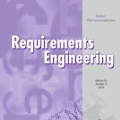In this paper, we report on our 5-year's practical experience of designing, developing and then deploying a Model-based Requirements Engineering (MBRE) approach and language in the context of three different large European collaborative projects providing complex software solutions. Based on data collected both during projects execution and via a survey realized afterwards, we intend to show that such an approach can bring interesting benefits in terms of scalability (e.g. large number of handled requirements), heterogeneity (e.g. partners with different types of RE background), traceability (e.g. from the requirements to the software components), automation (e.g. requirement documentation generation), usefulness or usability. To illustrate our contribution, we exemplify the application of our MBRE approach and language with concrete elements coming from one of these European research projects. We also discuss further the general benefits and current limitations of using this MBRE approach and corresponding language.
翻译:在本文中,我们报告我们五年来在三个不同的欧洲合作项目中设计、开发和部署基于模型的要求工程(MBRE)的方法和语言的实际经验,这三个不同的欧洲合作项目提供了复杂的软件解决方案,我们打算根据项目执行期间收集的数据以及随后通过调查收集的数据,表明这样一种方法在可扩展性(如大量处理的需求)、异质性(如具有不同类型RE背景的伙伴)、可追溯性(如从要求到软件组成部分)、自动化(如需求文件生成)、有用性或可用性等方面可带来令人感兴趣的好处,我们还进一步讨论使用这种MBRE方法和相应语言的一般好处和当前限制。为了说明我们的贡献,我们举例说明我们的MBRE方法和语言的应用,具体内容来自这些欧洲研究项目之一。我们还进一步讨论了使用这种MBRE方法和相应语言的一般好处和现有限制。





